

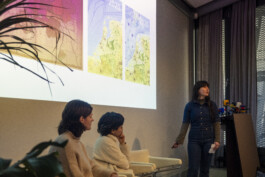
How will humans, nature, and technology relate to each other in the future? And what are desirable scenarios? In a two-year collaboration between STT and KABK, design students were asked to give shape to alternative technology visions, using a speculative design approach.
Commissioned by:
MA Industrial Design KABK, Stichting Toekomstbeeld der Techniek
How to give shape to hopes, fears, ideologies around technological inventions and make them tangible enough to compare and discuss? The work was based on five future scenarios developed by think tank Stichting Toekomstbeeld der Techniek. Working in groups, the students designed an artifact with an accompanying world around it. Ants take on a whole new role as guides through the natural environment and as seed dispersers. Autonomous, nomadic farm robots grow vegetables while roaming the land. Using wearables, humans live in symbiosis with all kinds of microorganisms.
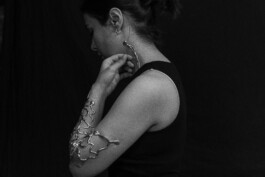

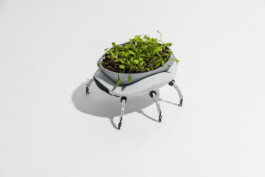
“Ant Maps” is a system featuring ants that serve as living cartographers. They guide the wearer using pheromone trails and gentle movement on the skin.
“Plant Wildlife Initiative” features a suit designed to digest fruits, then spread seeds during hiking trips.
Floods and droughts made conventional agriculture impossible. That’s why “Nomadic Farm Robots”carry the crops on their back and move around to find resources.
In the second year of the collaboration (2025) students were given the framework of “water justice”, but with no predefined scenarios. Instead, they began with their own research into places where water plays a central role. Based on their findings, they developed their own future scenarios in response to the brief: Whether scarcity or abundance, our relation to water is rapidly changing. Which (technological) strategies will life on Earth develop to cope with this fluctuating availability of water?
From farmers whose work becomes completely scheduled around the tides, to autonomous rock robots in Iceland that embody the warning voice of nature, or rivers that deserve to retire from being polluted: The students succeeded in bringing new relations to water and the environment to life, rather than only designing technical interventions.


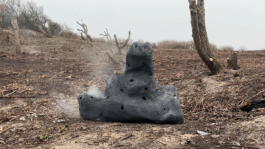
“Namib desert 2124” follows a nomad’s survival strategies to collect water under extreme water scarcity.
“Farming in a future dominated by water” explores what farming would look like if farmers depended on a tide clock for their work.
“The Symphony Alarm” harnesses geothermal steam from fumaroles to create harmonic sounds to warn people and animals of earthquakes.
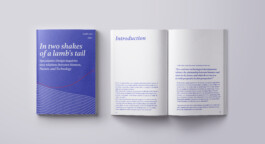


Publication designed by the students. A compilation of the research from all groups.
Student projects are featured in STT’s research publication “Voor niets gaat de zon op”.
Student projects are featured in “LEK – Between letting in and closing off: technology in just water futures” by Lisa Mandemaker from STT.
In this collaboration, we explored how research, foresight and speculative design can reinforce each other. By making possible futures tangible, the students reveal hidden values and perspectives. Through their choice of materials, design decisions, and visual storytelling, they offer new starting points for reflecting on our relationship with nature and technology. Each speculative artifact thus serves as an invitation to collectively explore the futures we can imagine, and those we are willing to make real.
During this course, the students honed their critical thinking skills in understanding technology and innovation as a result of socio-political climate. Furthermore, they developed their storytelling skills and how to use speculation as a tool to design for discourse.

YEAR
2023-2025
LOCATIONS
Royal Academy of Arts The Hague KABK (NL), Nieuwe Instituut (NL), Leiden University (NL)
DESIGN TEAM
Martina Huynh, Jonas Althaus
RESPONSIBILITIES
Mentoring, Lectures, Course Design
COLLABORATORS
Lisa Mandemaker (external advisor)
PHOTOGRAPHER
KABK MID Students, Vera Zhou
STUDENTS
Eline ten Busschen, Enora Cressan, Doğa Çakmakçi, Lucy Vink, Milena Eiras De Sanzo, Renan Zarpellon, Amber van Gastel, Mahtab Ghasemi, Eleonora Gasparini, Juraj Olejár, Marie Serra i Gil, Fahimeh Zare, Moritz Plöns, Maaike Helleman, Lida Andritsou, Zizi Mitrou, Lee Hun, Lot Dik, Benedetta Faccani, Fatima Kane, Léonie Hanen, Eva Rodinis, Micheal Sullivan, Riekje Paruschke, Linnis van Kampen, Ziqi Mao, Mila Tešić

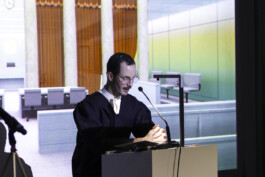

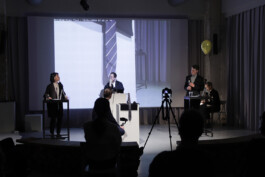

Through questions appearing on their phones, the audience joins in as the Grand Jury, who will ultimately weigh the pros and cons of Globalization's effect on humanity. What will Globalization say to defend itself?
Project partners:
MU Hybrid Art House, E-Werk Freiburg
How to give shape to hopes, fears, ideologies around technological inventions and make them tangible enough to compare and discuss? The work was based on five future scenarios developed by think tank Stichting Toekomstbeeld der Techniek. Working in groups, the students designed an artifact with an accompanying world around it. Ants take on a whole new role as guides through the natural environment and as seed dispersers. Autonomous, nomadic farm robots grow vegetables while roaming the land. Using wearables, humans live in symbiosis with all kinds of microorganisms.



“Ant Maps” is a system featuring ants that serve as living cartographers. They guide the wearer using pheromone trails and gentle movement on the skin.
“Plant Wildlife Initiative” features a suit designed to digest fruits, then spread seeds during hiking trips.
Floods and droughts made conventional agriculture impossible. That’s why “Nomadic Farm Robots”carry the crops on their back and move around to find resources.
In the second year of the collaboration (2025) students were given the framework of “water justice”, but with no predefined scenarios. Instead, they began with their own research into places where water plays a central role. Based on their findings, they developed their own future scenarios in response to the brief: Whether scarcity or abundance, our relation to water is rapidly changing. Which (technological) strategies will life on Earth develop to cope with this fluctuating availability of water?
From farmers whose work becomes completely scheduled around the tides, to autonomous rock robots in Iceland that embody the warning voice of nature, or rivers that deserve to retire from being polluted: The students succeeded in bringing new relations to water and the environment to life, rather than only designing technical interventions.



“Namib desert 2124” follows a nomad’s survival strategies to collect water under extreme water scarcity.
“Farming in a future dominated by water” explores what farming would look like if farmers depended on a tide clock for their work.
“The Symphony Alarm” harnesses geothermal steam from fumaroles to create harmonic sounds to warn people and animals of earthquakes.
In this collaboration, we explored how research, foresight and speculative design can reinforce each other. By making possible futures tangible, the students reveal hidden values and perspectives. Through their choice of materials, design decisions, and visual storytelling, they offer new starting points for reflecting on our relationship with nature and technology. Each speculative artifact thus serves as an invitation to collectively explore the futures we can imagine, and those we are willing to make real.
During this course, the students honed their critical thinking skills in understanding technology and innovation as a result of socio-political climate. Furthermore, they developed their storytelling skills and how to use speculation as a tool to design for discourse.
PROJECT TYPE
Commission
YEAR
2023-2025
LOCATIONS
Royal Academy of Arts The Hague KABK (NL), Nieuwe Instituut (NL), Leiden University (NL)
DESIGN TEAM
Martina Huynh, Jonas Althaus
RESPONSIBILITIES
Mentoring, Lectures, Course Design
COLLABORATORS
Lisa Mandemaker (external advisor)
PHOTOGRAPHER
KABK MID Students, Vera Zhou